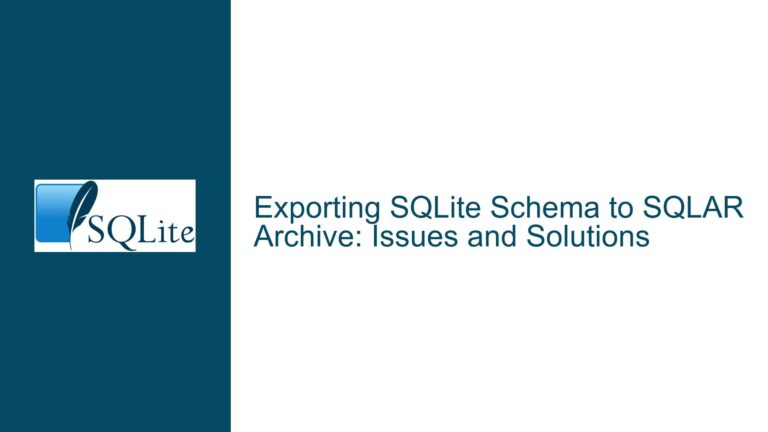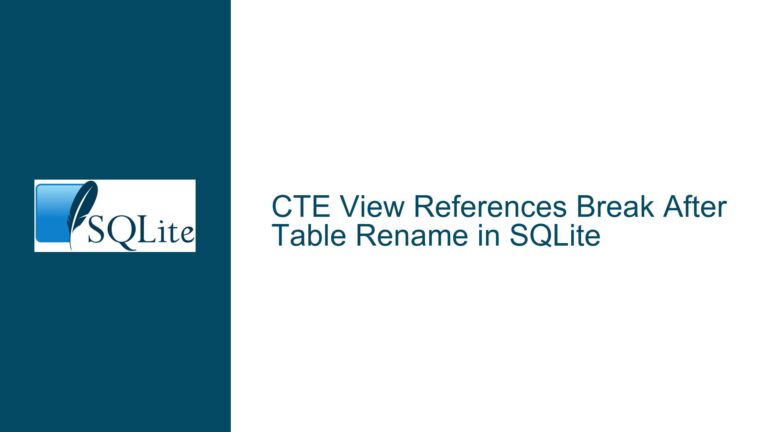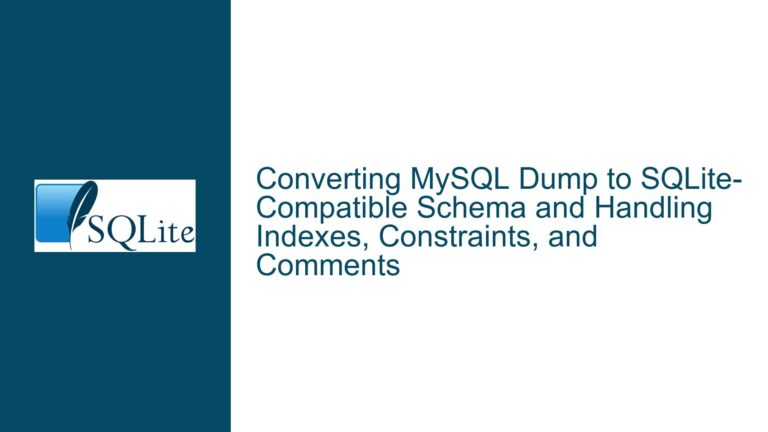Validating SQLite Database Integrity and Schema Consistency
Understanding Database Validity and Schema Verification
When working with SQLite databases, ensuring that a database is "valid" involves two primary aspects: structural integrity and schema consistency. Structural integrity refers to the database’s physical state, ensuring that the file is not corrupted and that all data pages are accessible. Schema consistency, on the other hand, ensures that the database contains the expected tables, columns, and relationships as defined by the application. This dual-layered approach is crucial for applications that rely on specific database structures to function correctly.
The concept of database validity extends beyond mere file existence or accessibility. It encompasses verifying that the database adheres to the expected schema and that the data within it is consistent with that schema. For instance, an application might require specific tables with predefined columns and relationships. If any of these elements are missing or altered, the database may be considered invalid, leading to potential application failures or data inconsistencies.
To address this, SQLite provides several mechanisms to validate both the structural integrity and schema consistency of a database. These include PRAGMA statements, schema verification techniques, and cryptographic hashing methods. Each of these approaches serves a distinct purpose and can be combined to create a robust validation process.
Common Causes of Database Invalidity and Schema Mismatches
Database invalidity can arise from various sources, ranging from file corruption to unintended schema modifications. Understanding these causes is essential for implementing effective validation strategies.
File Corruption: SQLite databases are stored as single files, making them susceptible to corruption due to hardware failures, improper shutdowns, or software bugs. Corruption can manifest as inaccessible data pages, missing tables, or inconsistent indexes. While SQLite is designed to be resilient, severe corruption can render a database unusable.
Schema Drift: Over time, the schema of a database may drift from its intended state due to manual modifications, application bugs, or incomplete migrations. Schema drift can result in missing tables, altered column definitions, or broken relationships. This drift can be subtle, making it challenging to detect without thorough verification.
Application-Specific Requirements: Some applications require databases to contain specific metadata or identifiers to be considered valid. For example, an application might expect a unique identifier or version number stored within the database. If this metadata is missing or incorrect, the database may be deemed invalid, even if the schema appears correct.
Foreign Key and Integrity Violations: SQLite supports foreign key constraints and integrity checks to enforce data consistency. However, these constraints may be disabled or violated due to application errors or manual interventions. Ensuring that foreign key relationships are intact and that data adheres to these constraints is crucial for maintaining database validity.
Comprehensive Validation Techniques and Solutions
To address the challenges of database validity and schema consistency, a combination of techniques can be employed. These techniques range from simple schema checks to advanced cryptographic verification methods.
Using PRAGMA Statements for Integrity Checks: SQLite provides several PRAGMA statements that can be used to verify the integrity and consistency of a database. The PRAGMA integrity_check command scans the database for structural issues, such as corrupted pages or missing indexes. If any issues are found, the command returns a list of errors that can be addressed to restore database integrity. Similarly, the PRAGMA foreign_key_check command verifies that all foreign key constraints are satisfied, ensuring data consistency.
Leveraging Application ID and User Version: SQLite allows applications to store metadata within the database using the application_id and user_version PRAGMAs. The application_id is a 32-bit signed integer that can be used to uniquely identify the database as belonging to a specific application. The user_version is another 32-bit integer that can store a version number or other metadata. By setting these values during database creation and verifying them during validation, applications can ensure that the database is both structurally and semantically valid.
Schema Verification Through Hashing: To detect schema drift or unauthorized modifications, cryptographic hashing can be employed. By generating a hash of the schema definition (stored in the sqlite_master table), applications can compare the computed hash with a known value to verify schema consistency. This approach is particularly useful for detecting subtle changes that might not be immediately apparent through manual inspection.
Combining Multiple Validation Techniques: For maximum reliability, combining multiple validation techniques is recommended. For example, an application might first verify the application_id and user_version to ensure the database belongs to the correct application and version. Next, it could perform an integrity check to detect any structural issues. Finally, it could compute a hash of the schema and compare it with a known value to ensure schema consistency. This multi-layered approach provides a robust defense against various forms of database invalidity.
Handling Edge Cases and Limitations: While the above techniques are effective, they are not without limitations. For instance, the PRAGMA integrity_check command may not detect all forms of corruption, especially if the corruption is subtle or localized. Similarly, schema hashing relies on the assumption that the schema definition is stored in a consistent format, which may not always be the case. To mitigate these limitations, applications should implement additional safeguards, such as regular backups and thorough testing.
Implementing Validation in Application Code: Integrating database validation into the application code ensures that validation is performed consistently and automatically. For example, an application might include a validation routine that runs each time the database is opened. This routine could check the application_id, perform an integrity check, and verify the schema hash. If any issues are detected, the application could either attempt to repair the database or prompt the user for further action.
Best Practices for Database Validation: To maximize the effectiveness of database validation, several best practices should be followed. These include setting the application_id and user_version during database creation, performing regular integrity checks, and using cryptographic hashing for schema verification. Additionally, applications should handle validation errors gracefully, providing meaningful feedback to users and logging detailed information for debugging purposes.
Advanced Techniques for Enhanced Security: For applications requiring enhanced security, additional techniques can be employed. For example, the schema hash could be encrypted and stored within the database, making it more difficult for attackers to tamper with the validation process. Similarly, the application_id could be combined with a secret key to create a unique identifier that is resistant to spoofing.
Conclusion: Validating the integrity and consistency of an SQLite database is a critical aspect of application development. By leveraging SQLite’s built-in PRAGMA statements, metadata storage capabilities, and cryptographic hashing techniques, developers can create robust validation processes that ensure database validity. Combining these techniques with best practices and advanced security measures further enhances the reliability and security of the validation process, providing a solid foundation for application stability and data integrity.






